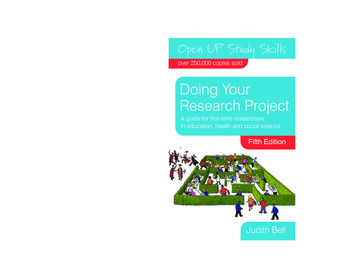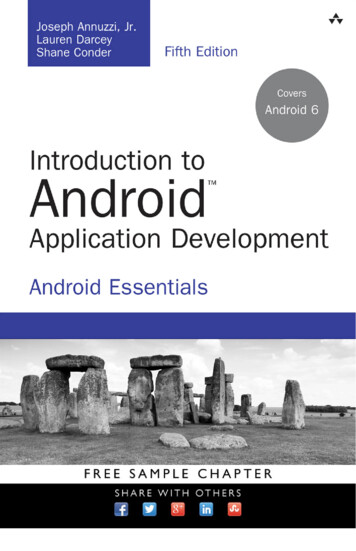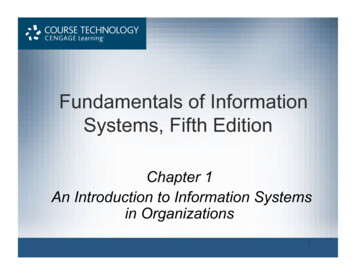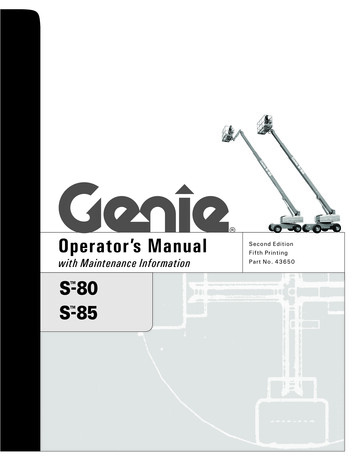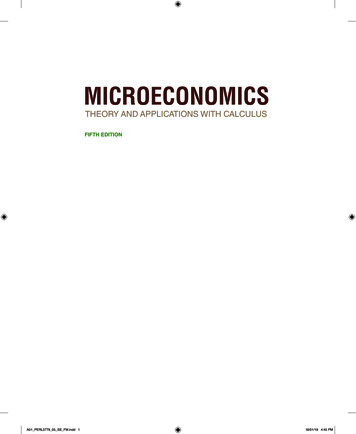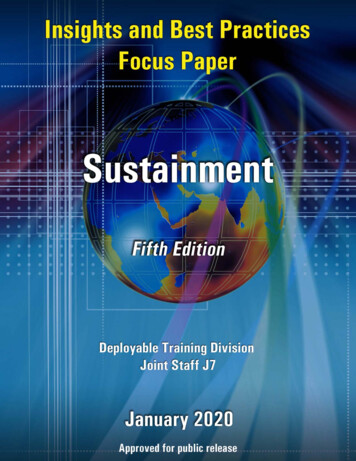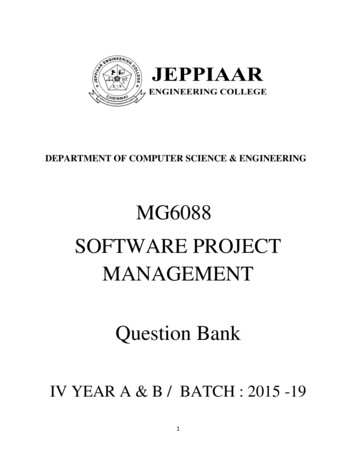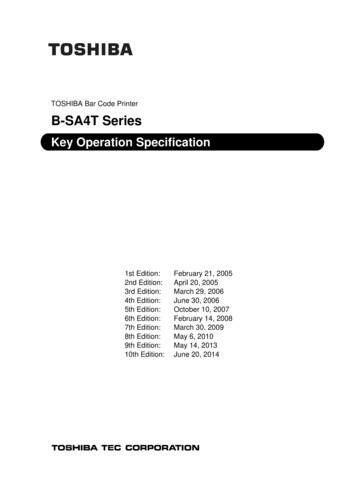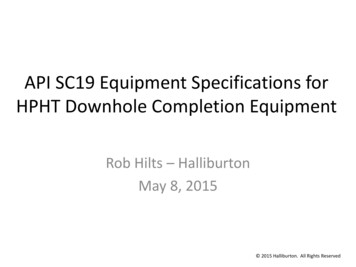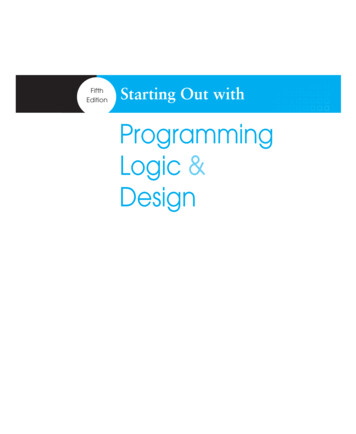
Transcription
FifthEditionStarting Out withProgrammingLogic &DesignA01 GADD1155 05 SE FM.indd 127/01/2018 09:40
A01 GADD1155 05 SE FM.indd 227/01/2018 09:40
FifthEditionStarting Out withProgrammingLogic &DesignTony GaddisHaywood Community College330 Hudson Street, NY 10013A01 GADD1155 05 SE FM.indd 327/01/2018 09:40
Senior Vice President Courseware Portfolio Management: Marcia HortonDirector, Portfolio Management: Engineering, Computer Science & Global Editions: Julian PartridgeSpecialist, Higher Ed Portfolio Management: Matt GoldsteinPortfolio Management Assistant: Meghan JacobyManaging Content Producer: Scott DisannoContent Producer: Carole SnyderWeb Developer: Steve WrightRights and Permissions Manager: Ben FerriniManufacturing Buyer, Higher Ed, Lake Side Communications Inc (LSC): Maura Zaldivar-GarciaInventory Manager: Ann LamProduct Marketing Manager: Yvonne VannattaField Marketing Manager: Demetrius HallMarketing Assistant: Jon BryantCover Designer: Joyce Wells, jWellsDesignFull-Service Project Management: Mohamed Hameed, SPi GlobalComposition: SPi GlobalCopyright 2019 by Pearson Education, Inc. or its affiliates. All Rights Reserved. Printed in the United States of America.This publication is protected by copyright, and permission should be obtained from the publisher prior to any prohibitedreproduction, storage in a retrieval system, or transmission in any form or by any means, electronic, mechanical,photocopying, recording, or otherwise. For information regarding permissions, request forms and the appropriate contactswithin the Pearson Education Global Rights & Permissions department, please visit www.pearsoned.com/permissions/.Unless otherwise indicated herein, any third-party trademarks that may appear in this work are the property of theirrespective owners and any references to third-party trademarks, logos or other trade dress are for demonstrative ordescriptive purposes only. Such references are not intended to imply any sponsorship, endorsement, authorization, orpromotion of Pearson’s products by the owners of such marks, or any relationship between the owner and PearsonEducation, Inc. or its affiliates, authors, licensees or distributors.Many of the designations by manufacturers and sellers to distinguish their products are claimed as trademarks. Where thosedesignations appear in this book, and the publisher was aware of a trademark claim, the designations have been printed ininitial caps or all caps.Microsoft and/or its respective suppliers make no representations about the suitability of the information contained in thedocuments and related graphics published as part of the services for any purpose. All such documents and related graphicsare provided “as is” without warranty of any kind. Microsoft and/or its respective suppliers hereby disclaim all warrantiesand conditions with regard to this information, including all warranties and conditions of merchantability. Whether express,implied or statutory, fitness for a particular.Purpose, title and non-infringement. In no event shall Microsoft and/or its respective suppliers be liable for any special,indirect or consequential damages or any damages whatsoever resulting from loss of use, data or profits, whether in anaction of contract. Negligence or other tortious action, arising out of or in connection with the use or performance ofinformation available from the services.The documents and related graphics contained herein could include technical inaccuracies or typographical errors. Changesare periodically added to the information herein. Microsoft and/or its respective suppliers may make improvements and/orchanges in the product(s) and/or the program(s) described herein at any time partial screen shots may be viewed in fullwithin the software version specified.Microsoft Windows , and Microsoft Office are registered trademarks of the Microsoft Corporation in the U.S.A. andother countries. This book is not sponsored or endorsed by or affiliated with the Microsoft Corporation.Library of Congress Cataloging-in-Publication DataNames: Gaddis, Tony, author.Title: Starting out with programming logic and design / with Tony Gaddis, Haywood Community College.Other titles: Starting out with programming logic & designDescription: Fifth edition. New York, NY Pearson Education, Inc., [2019] Earlier editions published under title: Startingout with programming logic & design. Includes index.Identifiers: LCCN 2017054391 ISBN 978-0-13-480115-5 ISBN 0-13-480115-6Subjects: LCSH: Computer programming.Classification: LCC QA76.6 .G315 2019 DDC 005.1—dc23 LC record available at https://lccn.loc.gov/2017054391118ISBN 10:0-13-480115-6ISBN 13: 978-0-13-480115-5A01 GADD1155 05 SE FM.indd 427/01/2018 09:40
Brief ContentsPrefacexiiiAcknowledgmentsxxiAbout the AuthorxxiiiChapter 1Introduction to Computers and Programming 1Chapter 2Input, Processing, and OutputChapter 3Modules 103Chapter 4Decision Structures and Boolean Logic 157Chapter 5Repetition Structures 217Chapter 6FunctionsChapter 7Input ValidationChapter 8ArraysChapter 9Sorting and Searching Arrays 419Chapter 10 Files27283333351469Chapter 11 Menu-Driven Programs 543Chapter 12 Text ProcessingChapter 13 Recursion595623Chapter 14 Object-Oriented Programming 649Chapter 15 GUI Applications and Event-Driven Programming 715Appendix A ASCII/Unicode Characters 747Appendix B Flowchart Symbols 749Appendix C Pseudocode Reference 751Appendix D Converting Decimal Numbers to BinaryAppendix E Answers to Checkpoint Questions765767Index 783vA01 GADD1155 05 SE FM.indd 527/01/2018 09:40
A01 GADD1155 05 SE FM.indd 627/01/2018 09:40
ContentsPrefaceChapter 1xiiiAcknowledgmentsxxiAbout the AuthorxxiiiIntroduction to Computers and Programming 11.1 Introduction. . . . . . . . . . . . . . . . . . . . . . . . . . . . . . . . . . . . . . . . . . . . . . . . . 11.2 Hardware. . . . . . . . . . . . . . . . . . . . . . . . . . . . . . . . . . . . . . . . . . . . . . . . . . . 21.3 How Computers Store Data. . . . . . . . . . . . . . . . . . . . . . . . . . . . . . . . . . . . . 71.4 How a Program Works. . . . . . . . . . . . . . . . . . . . . . . . . . . . . . . . . . . . . . . . 121.5 Types of Software . . . . . . . . . . . . . . . . . . . . . . . . . . . . . . . . . . . . . . . . . . . 20Review Questions. . . . . . . . . . . . . . . . . . . . . . . . . . . . . . . . . . . . . . . . . . . . . . . . 21Chapter 2Input, Processing, and Output272.1 Designing a Program . . . . . . . . . . . . . . . . . . . . . . . . . . . . . . . . . . . . . . . . .2.2 Output, Input, and Variables. . . . . . . . . . . . . . . . . . . . . . . . . . . . . . . . . . .2.3 Variable Assignment and Calculations . . . . . . . . . . . . . . . . . . . . . . . . . . .IN THE SPOTLIGHT: Calculating Cell Phone Overage Fees. . . . . . . . . . . . . . . . . . .IN THE SPOTLIGHT: Calculating a Percentage . . . . . . . . . . . . . . . . . . . . . . . . . . . .IN THE SPOTLIGHT: Calculating an Average . . . . . . . . . . . . . . . . . . . . . . . . . . . . .IN THE SPOTLIGHT: Converting a Math Formula to a Programming Statement. . .2.4 Variable Declarations and Data Types. . . . . . . . . . . . . . . . . . . . . . . . . . .2.5 Named Constants . . . . . . . . . . . . . . . . . . . . . . . . . . . . . . . . . . . . . . . . . . .2.6 Hand Tracing a Program . . . . . . . . . . . . . . . . . . . . . . . . . . . . . . . . . . . . . .2.7 Documenting a Program. . . . . . . . . . . . . . . . . . . . . . . . . . . . . . . . . . . . . .IN THE SPOTLIGHT: Using Named Constants, Style Conventions,and Comments. . . . . . . . . . . . . . . . . . . . . . . . . . . . . . . . . . . . . . . . . . . . . .2.8 Designing Your First Program. . . . . . . . . . . . . . . . . . . . . . . . . . . . . . . . . . .2.9 Focus on Languages: Java, Python, and C . . . . . . . . . . . . . . . . . . . . . . .Review Questions. . . . . . . . . . . . . . . . . . . . . . . . . . . . . . . . . . . . . . . . . . . . . . . .Debugging Exercises. . . . . . . . . . . . . . . . . . . . . . . . . . . . . . . . . . . . . . . . . . . . . .Programming Exercises. . . . . . . . . . . . . . . . . . . . . . . . . . . . . . . . . . . . . . . . . . . .2734434749525557626465666872929798viiA01 GADD1155 05 SE FM.indd 727/01/2018 09:40
viiiContentsChapter 3Modules1033.1 Introduction to Modules. . . . . . . . . . . . . . . . . . . . . . . . . . . . . . . . . . . . .3.2 Defining and Calling a Module. . . . . . . . . . . . . . . . . . . . . . . . . . . . . . . .IN THE SPOTLIGHT: Defining and Calling Modules. . . . . . . . . . . . . . . . . . . . . . .3.3 Local Variables. . . . . . . . . . . . . . . . . . . . . . . . . . . . . . . . . . . . . . . . . . . . .3.4 Passing Arguments to Modules. . . . . . . . . . . . . . . . . . . . . . . . . . . . . . . .IN THE SPOTLIGHT: Passing an Argument to a Module. . . . . . . . . . . . . . . . . . . .IN THE SPOTLIGHT: Passing an Argument by Reference. . . . . . . . . . . . . . . . . . . .3.5 Global Variables and Global Constants . . . . . . . . . . . . . . . . . . . . . . . . .IN THE SPOTLIGHT: Using Global Constants. . . . . . . . . . . . . . . . . . . . . . . . . . . .3.6 Focus on Languages: Java, Python, and C . . . . . . . . . . . . . . . . . . . . . .Review Questions. . . . . . . . . . . . . . . . . . . . . . . . . . . . . . . . . . . . . . . . . . . . . . .Debugging Exercises. . . . . . . . . . . . . . . . . . . . . . . . . . . . . . . . . . . . . . . . . . . . .Programming Exercises. . . . . . . . . . . . . . . . . . . . . . . . . . . . . . . . . . . . . . . . . . .Chapter 4Decision Structures and Boolean Logic 1574.1 Introduction to Decision Structures . . . . . . . . . . . . . . . . . . . . . . . . . . . .IN THE SPOTLIGHT: Using the If-Then Statement. . . . . . . . . . . . . . . . . . . . . . .4.2 Dual Alternative Decision Structures. . . . . . . . . . . . . . . . . . . . . . . . . . . .IN THE SPOTLIGHT: Using the If-Then-Else Statement. . . . . . . . . . . . . . . . . .4.3 Comparing Strings. . . . . . . . . . . . . . . . . . . . . . . . . . . . . . . . . . . . . . . . . .4.4 Nested Decision Structures. . . . . . . . . . . . . . . . . . . . . . . . . . . . . . . . . . .IN THE SPOTLIGHT: Multiple Nested Decision Structures . . . . . . . . . . . . . . . . . .4.5 The Case Structure. . . . . . . . . . . . . . . . . . . . . . . . . . . . . . . . . . . . . . . . . .IN THE SPOTLIGHT: Using a Case Structure. . . . . . . . . . . . . . . . . . . . . . . . . . . . .4.6 Logical Operators. . . . . . . . . . . . . . . . . . . . . . . . . . . . . . . . . . . . . . . . . . .4.7 Boolean Variables . . . . . . . . . . . . . . . . . . . . . . . . . . . . . . . . . . . . . . . . . .4.8 Focus on Languages: Java, Python, and C . . . . . . . . . . . . . . . . . . . . . .Review Questions. . . . . . . . . . . . . . . . . . . . . . . . . . . . . . . . . . . . . . . . . . . . . . .Debugging Exercises. . . . . . . . . . . . . . . . . . . . . . . . . . . . . . . . . . . . . . . . . . . . .Programming Exercises. . . . . . . . . . . . . . . . . . . . . . . . . . . . . . . . . . . . . . . . . . .Chapter tition Structures 2175.1 Introduction to Repetition Structures. . . . . . . . . . . . . . . . . . . . . . . . . . .5.2 Condition-Controlled Loops: While, Do-While, and Do-Until. . . . .IN THE SPOTLIGHT: Designing a While Loop. . . . . . . . . . . . . . . . . . . . . . . . . . .IN THE SPOTLIGHT: Designing a Do-While Loop. . . . . . . . . . . . . . . . . . . . . . . .5.3 Count-Controlled Loops and the For Statement. . . . . . . . . . . . . . . . . .IN THE SPOTLIGHT: Designing a Count-Controlled Loopwith the For Statement . . . . . . . . . . . . . . . . . . . . . . . . . . . . . . . . . . . . . .5.4 Calculating a Running Total . . . . . . . . . . . . . . . . . . . . . . . . . . . . . . . . . .A01 GADD1155 05 SE FM.indd 3223724525527/01/2018 09:40
Contents5.5 Sentinels . . . . . . . . . . . . . . . . . . . . . . . . . . . . . . . . . . . . . . . . . . . . . . . . .IN THE SPOTLIGHT: Using a Sentinel. . . . . . . . . . . . . . . . . . . . . . . . . . . . . . . . . .5.6 Nested Loops. . . . . . . . . . . . . . . . . . . . . . . . . . . . . . . . . . . . . . . . . . . . . .5.7 Focus on Languages: Java, Python, and C . . . . . . . . . . . . . . . . . . . . . .Review Questions. . . . . . . . . . . . . . . . . . . . . . . . . . . . . . . . . . . . . . . . . . . . . . .Debugging Exercises. . . . . . . . . . . . . . . . . . . . . . . . . . . . . . . . . . . . . . . . . . . . .Programming Exercises. . . . . . . . . . . . . . . . . . . . . . . . . . . . . . . . . . . . . . . . . . .Chapter 6FunctionsInput ValidationArrays3333343363413423463483493518.1 Array Basics . . . . . . . . . . . . . . . . . . . . . . . . . . . . . . . . . . . . . . . . . . . . . . .IN THE SPOTLIGHT: Using Array Elements in a Math Expression . . . . . . . . . . . .8.2 Sequentially Searching an Array . . . . . . . . . . . . . . . . . . . . . . . . . . . . . . .8.3 Processing the Contents of an Array . . . . . . . . . . . . . . . . . . . . . . . . . . . .IN THE SPOTLIGHT: Processing an Array. . . . . . . . . . . . . . . . . . . . . . . . . . . . . . .8.4 Parallel Arrays . . . . . . . . . . . . . . . . . . . . . . . . . . . . . . . . . . . . . . . . . . . . .IN THE SPOTLIGHT: Using Parallel Arrays. . . . . . . . . . . . . . . . . . . . . . . . . . . . . .8.5 Two-Dimensional Arrays. . . . . . . . . . . . . . . . . . . . . . . . . . . . . . . . . . . . .IN THE SPOTLIGHT: Using a Two-Dimensional Array . . . . . . . . . . . . . . . . . . . . .8.6 Arrays of Three or More Dimensions. . . . . . . . . . . . . . . . . . . . . . . . . . . .A01 GADD1155 05 SE FM.indd 92832872902922983073173243273283337.1 Garbage In, Garbage Out . . . . . . . . . . . . . . . . . . . . . . . . . . . . . . . . . . . .7.2 The Input Validation Loop. . . . . . . . . . . . . . . . . . . . . . . . . . . . . . . . . . . .IN THE SPOTLIGHT: Designing an Input Validation Loop . . . . . . . . . . . . . . . . . .7.3 Defensive Programming. . . . . . . . . . . . . . . . . . . . . . . . . . . . . . . . . . . . . .7.4 Focus on Languages: Java, Python, and C . . . . . . . . . . . . . . . . . . . . . .Review Questions. . . . . . . . . . . . . . . . . . . . . . . . . . . . . . . . . . . . . . . . . . . . . . .Debugging Exercises. . . . . . . . . . . . . . . . . . . . . . . . . . . . . . . . . . . . . . . . . . . . .Programming Exercises. . . . . . . . . . . . . . . . . . . . . . . . . . . . . . . . . . . . . . . . . . .Chapter 82592602632662752782792836.1 Introduction to Functions: Generating Random Numbers. . . . . . . . . . .IN THE SPOTLIGHT: Using Random Numbers . . . . . . . . . . . . . . . . . . . . . . . . . . .IN THE SPOTLIGHT: Using Random Numbers to Represent Other Values . . . . . .6.2 Writing Your Own Functions. . . . . . . . . . . . . . . . . . . . . . . . . . . . . . . . . .IN THE SPOTLIGHT: Modularizing with Functions. . . . . . . . . . . . . . . . . . . . . . . .6.3 More Library Functions. . . . . . . . . . . . . . . . . . . . . . . . . . . . . . . . . . . . . .6.4 Focus on Languages: Java, Python, and C . . . . . . . . . . . . . . . . . . . . . .Review Questions. . . . . . . . . . . . . . . . . . . . . . . . . . . . . . . . . . . . . . . . . . . . . . .Debugging Exercises. . . . . . . . . . . . . . . . . . . . . . . . . . . . . . . . . . . . . . . . . . . . .Programming Exercises. . . . . . . . . . . . . . . . . . . . . . . . . . . . . . . . . . . . . . . . . . .Chapter 7ix35135836537137838538639039339827/01/2018 09:40
xContents8.7 Focus on Languages: Java, Python, and C . . . . . . . . . . . . . . . . . . . . . .Review Questions. . . . . . . . . . . . . . . . . . . . . . . . . . . . . . . . . . . . . . . . . . . . . . .Debugging Exercises. . . . . . . . . . . . . . . . . . . . . . . . . . . . . . . . . . . . . . . . . . . . .Programming Exercises. . . . . . . . . . . . . . . . . . . . . . . . . . . . . . . . . . . . . . . . . . .Chapter 9399409412413Sorting and Searching Arrays 4199.1 The Bubble Sort Algorithm . . . . . . . . . . . . . . . . . . . . . . . . . . . . . . . . . . .IN THE SPOTLIGHT: Using the Bubble Sort Algorithm. . . . . . . . . . . . . . . . . . . . .9.2 The Selection Sort Algorithm. . . . . . . . . . . . . . . . . . . . . . . . . . . . . . . . . .9.3 The Insertion Sort Algorithm. . . . . . . . . . . . . . . . . . . . . . . . . . . . . . . . . .9.4 The Binary Search Algorithm. . . . . . . . . . . . . . . . . . . . . . . . . . . . . . . . . .IN THE SPOTLIGHT: Using the Binary Search Algorithm. . . . . . . . . . . . . . . . . . . .9.5 Focus on Languages: Java, Python, and C . . . . . . . . . . . . . . . . . . . . . .Review Questions. . . . . . . . . . . . . . . . . . . . . . . . . . . . . . . . . . . . . . . . . . . . . . .Debugging Exercises. . . . . . . . . . . . . . . . . . . . . . . . . . . . . . . . . . . . . . . . . . . . .Programming Exercises. . . . . . . . . . . . . . . . . . . . . . . . . . . . . . . . . . . . . . . . . . .Chapter 10 Files41942643343944544945146446746746910.1 Introduction to File Input and Output . . . . . . . . . . . . . . . . . . . . . . . . . .10.2 Using Loops to Process Files. . . . . . . . . . . . . . . . . . . . . . . . . . . . . . . . . .IN THE SPOTLIGHT: Working with Files. . . . . . . . . . . . . . . . . . . . . . . . . . . . . . . .10.3 Using Files and Arrays . . . . . . . . . . . . . . . . . . . . . . . . . . . . . . . . . . . . . . .10.4 Processing Records. . . . . . . . . . . . . . . . . . . . . . . . . . . . . . . . . . . . . . . . . .IN THE SPOTLIGHT: Adding and Displaying Records. . . . . . . . . . . . . . . . . . . . . .IN THE SPOTLIGHT: Searching for a Record. . . . . . . . . . . . . . . . . . . . . . . . . . . . .IN THE SPOTLIGHT: Modifying Records. . . . . . . . . . . . . . . . . . . . . . . . . . . . . . . .IN THE SPOTLIGHT: Deleting Records . . . . . . . . . . . . . . . . . . . . . . . . . . . . . . . . .10.5 Control Break Logic. . . . . . . . . . . . . . . . . . . . . . . . . . . . . . . . . . . . . . . . .IN THE SPOTLIGHT: Using Control Break Logic. . . . . . . . . . . . . . . . . . . . . . . . . .10.6 Focus on Languages: Java, Python, and C . . . . . . . . . . . . . . . . . . . . . .Review Questions. . . . . . . . . . . . . . . . . . . . . . . . . . . . . . . . . . . . . . . . . . . . . . .Debugging Exercises. . . . . . . . . . . . . . . . . . . . . . . . . . . . . . . . . . . . . . . . . . . . .Programming Exercises. . . . . . . . . . . . . . . . . . . . . . . . . . . . . . . . . . . . . . . . . . ter 11 Menu-Driven Programs 54311.1 Introduction to Menu-Driven Programs . . . . . . . . . . . . . . . . . . . . . . . . .11.2 Modularizing a Menu-Driven Program . . . . . . . . . . . . . . . . . . . . . . . . . .11.3 Using a Loop to Repeat the Menu. . . . . . . . . . . . . . . . . . . . . . . . . . . . . .IN THE SPOTLIGHT: Designing a Menu-Driven Program . . . . . . . . . . . . . . . . . . .11.4 Multiple-Level Menus. . . . . . . . . . . . . . . . . . . . . . . . . . . . . . . . . . . . . . .11.5 Focus on Languages: Java, Python, and C . . . . . . . . . . . . . . . . . . . . . .A01 GADD1155 05 SE FM.indd 1054355455956457858427/01/2018 09:40
ContentsxiReview Questions. . . . . . . . . . . . . . . . . . . . . . . . . . . . . . . . . . . . . . . . . . . . . . . 590Programming Exercises. . . . . . . . . . . . . . . . . . . . . . . . . . . . . . . . . . . . . . . . . . . 592Chapter 12 Text Processing 59512.1 Introduction. . . . . . . . . . . . . . . . . . . . . . . . . . . . . . . . . . . . . . . . . . . . . . . 59512.2 Character-by-Character Text Processing . . . . . . . . . . . . . . . . . . . . . . . . . 597IN THE SPOTLIGHT: Validating a Password. . . . . . . . . . . . . . . . . . . . . . . . . . . . . 600IN THE SPOTLIGHT: Formatting and Unformatting Telephone Numbers. . . . . . . 60612.3 Focus on Languages: Java, Python, and C . . . . . . . . . . . . . . . . . . . . . . 611Review Questions. . . . . . . . . . . . . . . . . . . . . . . . . . . . . . . . . . . . . . . . . . . . . . . 617Debugging Exercises. . . . . . . . . . . . . . . . . . . . . . . . . . . . . . . . . . . . . . . . . . . . . 619Programming Exercises. . . . . . . . . . . . . . . . . . . . . . . . . . . . . . . . . . . . . . . . . . . 620Chapter 13 Recursion62313.1 Introduction to Recursion. . . . . . . . . . . . . . . . . . . . . . . . . . . . . . . . . . . .13.2 Problem Solving with Recursion. . . . . . . . . . . . . . . . . . . . . . . . . . . . . . .13.3 Examples of Recursive Algorithms. . . . . . . . . . . . . . . . . . . . . . . . . . . . . .13.4 Focus on Languages: Java, Python, and C . . . . . . . . . . . . . . . . . . . . . .Review Questions. . . . . . . . . . . . . . . . . . . . . . . . . . . . . . . . . . . . . . . . . . . . . . .Programming Exercises. . . . . . . . . . . . . . . . . . . . . . . . . . . . . . . . . . . . . . . . . . .623626630640645647Chapter 14 Object-Oriented Programming 64914.114.214.314.4Procedural and Object-Oriented Programming. . . . . . . . . . . . . . . . . . . .Classes. . . . . . . . . . . . . . . . . . . . . . . . . . . . . . . . . . . . . . . . . . . . . . . . . . .Using the Unified Modeling Language to Design Classes. . . . . . . . . . . .Finding the Classes and Their Responsibilities in a Problem. . . . . . . . . .IN THE SPOTLIGHT: Finding the Classes in a Problem . . . . . . . . . . . . . . . . . . . . .IN THE SPOTLIGHT: Determining Class Responsibilities. . . . . . . . . . . . . . . . . . . .14.5 Inheritance. . . . . . . . . . . . . . . . . . . . . . . . . . . . . . . . . . . . . . . . . . . . . . . .14.6 Polymorphism. . . . . . . . . . . . . . . . . . . . . . . . . . . . . . . . . . . . . . . . . . . . .14.7 Focus on Languages: Java, Python, and C . . . . . . . . . . . . . . . . . . . . . .Review Questions. . . . . . . . . . . . . . . . . . . . . . . . . . . . . . . . . . . . . . . . . . . . . . .Programming Exercises. . . . . . . . . . . . . . . . . . . . . . . . . . . . . . . . . . . . . . . . . . .649653664667667671677685689707710Chapter 15 GUI Applications and Event-DrivenProgramming 71515.1 Graphical User Interfaces. . . . . . . . . . . . . . . . . . . . . . . . . . . . . . . . . . . . .15.2 Designing the User Interface for a GUI Program . . . . . . . . . . . . . . . . . . .IN THE SPOTLIGHT: Designing a Window . . . . . . . . . . . . . . . . . . . . . . . . . . . . . .15.3 Writing Event Handlers . . . . . . . . . . . . . . . . . . . . . . . . . . . . . . . . . . . . . .A01 GADD1155 05 SE FM.indd 1171571872372527/01/2018 09:40
xiiContentsDesigning an Event Handler. . . . . . . . . . . . . . . . . . . . . . . . .15.4 Designing Apps for Mobile Devices. . . . . . . . . . . . . . . . . . . . . . . . . . . . .15.5 Focus on Languages: Java, Python, and C . . . . . . . . . . . . . . . . . . . . . .Review Questions. . . . . . . . . . . . . . . . . . . . . . . . . . . . . . . . . . . . . . . . . . . . . . .Programming Exercises. . . . . . . . . . . . . . . . . . . . . . . . . . . . . . . . . . . . . . . . . . .IN THE SPOTLIGHT:728731740741744Appendix A ASCII/Unicode Characters 747Appendix B Flowchart Symbols749Appendix C Pseudocode Reference 751Appendix D Converting Decimal Numbers to BinaryAppendix E Answers to Checkpoint QuestionsIndexA01 GADD1155 05 SE FM.indd 1276576778327/01/2018 09:40
PrefaceWelcome to Starting Out with Programming Logic and Design, Fifth Edition. Thisbook uses a language-independent approach to teach programming conceptsand problem-solving skills, without assuming any previous programming experience. By using easy-to-understand pseudocode, flowcharts, and other tools, the studentlearns how to design the logic of programs without the complication of language syntax.Fundamental topics such as data types, variables, input, output, control structures,modules, functions, arrays, and files are covered as well as object-oriented concepts,GUI development, and event-driven programming. As with all the books in the StartingOut With . . . series, this text is written in clear, easy-to-understand language that students find friendly and inviting.Each chapter presents a multitude of program design examples. Short examples thathighlight specific programming topics are provided, as well as more involved examplesthat focus on problem solving. Each chapter includes at least one In the Spotlight section that provides step-by-step analysis of a specific problem and demonstrates a solution to that problem.This book is ideal for a programming logic course that is taught as a precursor to alanguage-specific introductory programming course, or for the first part of an introductory programming course in which a specific language is taught.Changes in the Fifth EditionThis book’s pedagogy, organization, and clear writing style remain the same as in theprevious edition. Many improvements have been made, which are summarized here: A new section titled Focus on Languages: Java, Python, and C appears at theend of Chapters 2–15. This section discusses how the chapter’s main topics areimplemented in the Java, Python, and C programming languages. This sectiongives code snippet examples and complete programs in each of these languages. Itis a valuable tool that students can use to learn the concepts of each chapter inone or more of these programming languages.A new section on the Init() module has been added to Chapter 15. This moduleis a startup module in a GUI application, similar to the start method in a JavaFXapplication, or the Form Load handler in a Windows Forms application.A new section titled Designing Apps for Mobile Devices has been added to Chapter 15. This new section discusses some of the common issues developersface when designing apps for mobile devices. The student is also introduced tocoding concepts related to a mobile device’s special hardware capabilities, such assending and receiving text messages, making and receiving phone calls, anddetecting the device’s location. Several pseudocode examples are given for a simulated smartphone.xiiiA01 GADD1155 05 SE FM.indd 1327/01/2018 09:40
xivPreface New motivational programming exercises have been added to several chapters.The book’s Language Reference Guides have been updated. All of thebook’s Language Reference Guides are available on the book’s resource site at:www.pearson.com/cs-resources.Brief Overview of Each ChapterChapter 1: Introduction to Computers and ProgrammingThis chapter begins by giving a concise and easy-to-understand explanation of howcomputers work, how data is stored and manipulated, and why we write programs inhigh-level languages.Chapter 2: Input, Processing, and OutputThis chapter introduces the program development cycle, data types, variables, andsequence structures. The student learns to use pseudocode and flowcharts to designsimple programs that read input, perform mathematical operations, and producescreen output.Chapter 3: ModulesThis chapter demonstrates the benefits of modularizing programs and using the topdown design approach. The student learns to define and call modules, pass argumentsto modules, and use local variables. Hierarchy charts are introduced as a design tool.Chapter 4: Decision Structures and Boolean LogicIn this chapter students explore relational operators and Boolean expressions and areshown how to control the flow of a program with decision structures. The If-Then,If-Then-Else, and If-Then-Else If statements are covered. Nested decision structures, logical operators, and the case structure are also discussed.Chapter 5: Repetition StructuresThis chapter shows the student how to use loops to create repetition structures. TheWhile, Do-While, Do-Until, and For loops are presented. Counters, accumulators,running totals, and sentinels are also discussed.Chapter 6: FunctionsThis chapter begins by discussing common library functions, such as those for generating random numbers. After learning how to call library functions and how to use values returned by functions, the student learns how to define and call his or her ownfunctions.Chapter 7: Input ValidationThis chapter discusses the importance of validating user input. The student learns towrite input validation loops that serve as error traps. Defensive programming and theimportance of anticipating obvious as well as unobvious errors is discussed.A01 GADD1155 05 SE FM.indd 1427/01/2018 09:40
PrefacexvChapter 8: ArraysIn this chapter the student learns to create and work with one- and two-dimensionalarrays. Many examples of array processing are provided including examples illustrating how to find the sum, average, and highest and lowest values in an array, and howto sum the rows, columns, and all elements of a two-dimensional array. Programmingtechniques using parallel arrays are also demonstrated.Chapter 9: Sorting and Searching ArraysIn this chapter the student learns the basics of sorting arrays and searching for datastored in them. The chapter covers the bubble sort, selection sort, insertion sort, andbinary search algorithms.Chapter 10: FilesThis chapter introduces sequential file input and output. The student learns to read andwrite large sets of data, store data as fields and records, and design programs that workwith both files and arrays. The chapter concludes by discussing control break processing.Chapter 11: Menu-Driven ProgramsIn this chapter the student learns to design programs that display menus and executetasks according to the user’s menu selection. The importance of modularizing a menudriven program is also discussed.Chapter 12: Text ProcessingThis chapter discusses text processing at a detailed level. Algorithms that step throughthe individual characters in a string are discussed, and several common library functions for character and text processing are introduced.Cha
Fifth Edition Programming Logic & Design Starting Out with 330 Hudson Street, NY 10013 Tony Gaddis Haywood Commun
